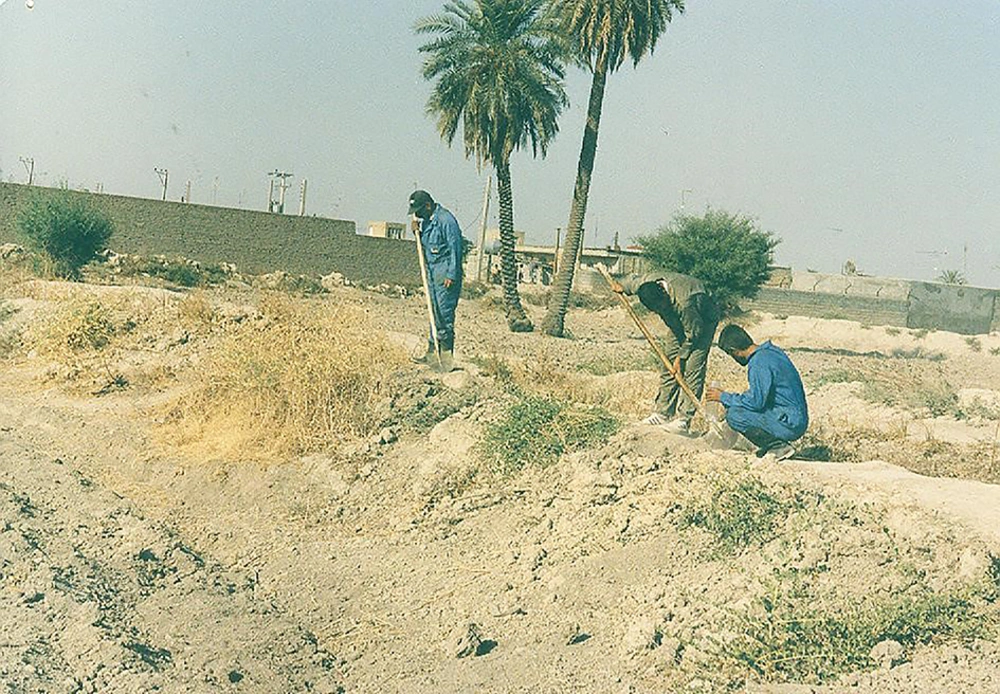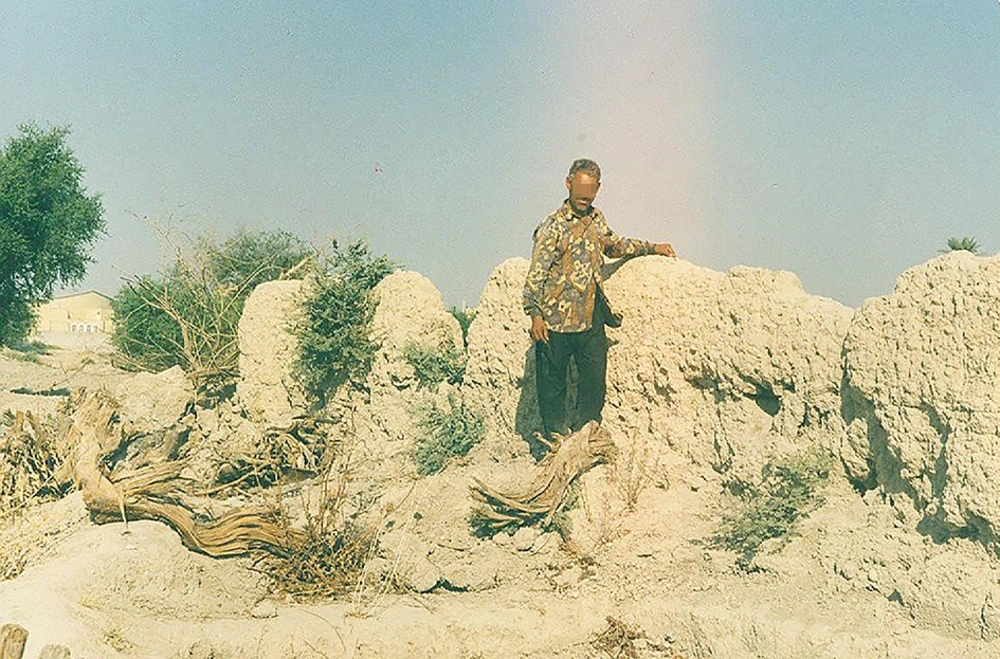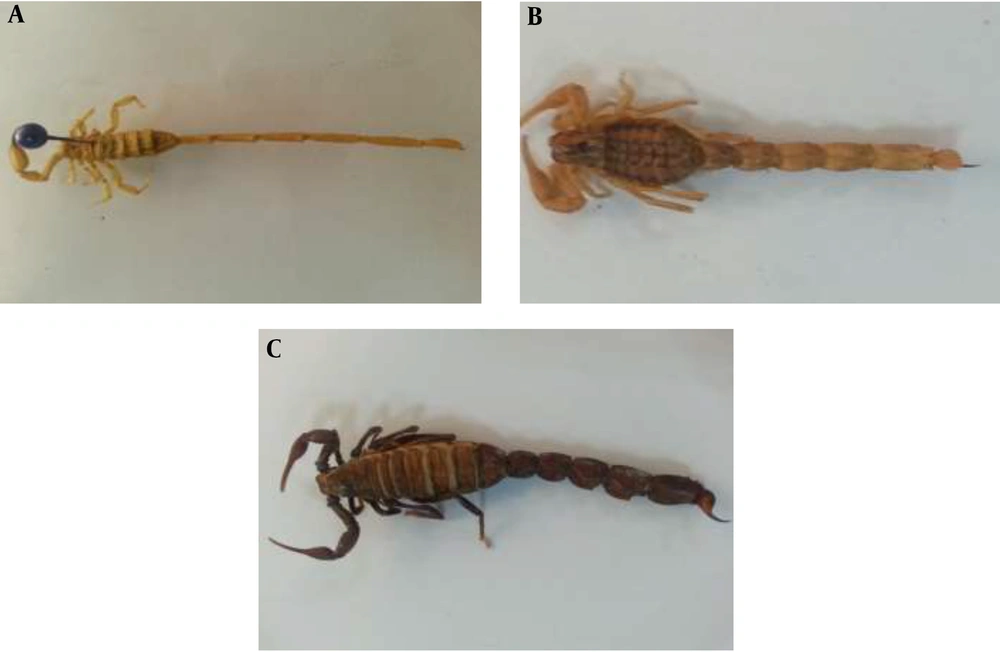1. Background
Humans may be exposed to a variety of arthropods, ranging from dangerous non-venomous to venomous and even fatal ones (1). The bites or stings of some arthropods may cause infection, poisoning, and disease (2, 3). With respect to its climatic diversity, Iran is one of the richest countries from the point of view of arthropods fauna. The venomous animals in Iran have long been paid a specific attention. The stings or bites by such animals, as scorpions and snakes, have always been a medical issue in the country. Although the fauna diversity stretches from Iranian islands in Persian Gulf to northern region of the country, they are more frequent in hot climates. Every year, there are reported cases of scorpion stings and snakebites (4-7). Scorpions have been initially important for their grievous, toxic and in some cases deadly sting (8). Identification of biological, nutritive, and ecological characteristics of scorpions is very common in scientific studies in the field of genetics, physiology, ecology, etc. (9). These arthropods have always received attention by Iranian people (10).
Scorpions are amongst the most important venomous creatures in the world, specifically in tropical and subtropical regions. Each year, 1.2 to 1.5 million individuals are stung by scorpions throughout the globe, out of which three to five thousand lead to death (11). Scorpions are more common in the arid and tropical areas, including deserts (12). The incidence of scorpion stings varies in different regions and countries, based on lifestyle, provision of health care services, and species.
The Khuzestan province is located in the southwestern of Iran, bordering the Persian Gulf and Iraq. Its capital is Ahvaz county and it’s area is 63238 km2. Southern and southwestern regions of Iran are rich in scorpion species diversity. Scorpions reported in Iran are classified to three families. These families include Scorpionidae, Hemiscorpiidae, and Buthidae. The above-mentioned families contain 20 genera and 64 species. From among these 64 species, 55 belong to the Buthidae (86%), six to the Hemiscorpiidae (9.5%), and three to the Scorpionidae (4.5%). The Hemiscorpius lepturus is one of the perilous species of the Hemiscorpiidae. Meanwhile, Androctonus crassicauda is the most dangerous and deadliest member of the Buthidae family in Iran. On the other hand, members of the Scorpionidae family are not of much medical significance (13). Taxonomy of scorpions in the globe and likewise in Iran, faces certain challenges due to lack of scientific techniques of classification and nomenclature. Despite development of biochemical tests and molecular techniques, the morphometric techniques are still used for classification.
Researchers, who are active in scientific fields look at scorpions from a variety of different perspectives. Every specialist has to capture scorpion samples during field studies. There are about ten techniques for collecting scorpions based on objectives and research type, including rock-rolling, pitfall trap, water-pan trap, the use of black light, adobe and mud walls destruction, collecting scorpions by stung persons, pouring water into their habitats, excavation canals, utilization of a rubber tape and usage a soaked gunny or cloth. Pitfall trap and black light are the most abundantly used techniques for scorpion collection at night. Also, moving stones in their habitat is the most important technique for collection during the day. The methods differ based on various groups of arthropods and geographical location. Under certain circumstances, the researcher perhaps utilizes all techniques of scorpion collection (14). So far, more than two thousand species of scorpion have been distinguished, some of which have medical-health significance in various countries, including Iran (15, 16). An important issue in this area is the mode of capturing scorpions in their natural desert and mountainous habitats and their species composition and abundance. These techniques vary for various groups of medically important arthropods and in various geographical areas. Due to the significance of scorpions, this research aimed to compare various techniques of collecting scorpions in the field.
2. Objectives
Regarding the importance of capturing methods, this study intended to compare them in natural desert and mountainous habitats of Khuzestan province, Southwestern of Iran. The results of this study can be used for control programs for scorpion sting, and hence can reduce their incidence in the province.
3. Methods
The Kashan Health School Research Arbitration Committee improved the research project based on stipulations and law. Consequently, the ethics fundamental of this study were verified and explained by the Research Committee of the Social Determinants of Health Research Center and Department of Environmental Health, Kashan University of Medical Sciences, Kashan, Iran, and after making required corrections, it was confirmed. The research was performed based on provisions of the Helsinki Declaration.
In this descriptive field study, different species of scorpions were captured in 26 sampling sessions from urban and rural areas Bagh-e Malek (31° 31' 25" North, 49° 53' 22" East), Izeh (31° 50' 14" North, 49° 52' 10" East), Ramhormoz (31° 16' 42" North, 49° 36' 23" East), Shush (32° 11' 26" North, 48° 15' 28" East), Ahvaz (31° 19' 45" North, 48° 41' 28" East), and Hamidiyeh (31° 29' 6" North, 48° 26' 7" East) in Khuzestan province, during fall and winter. The hunting sites under investigation in these counties were located in residential districts and their marginal areas. The samples were collected using the black light technique at night, and rock-rolling, digging, old mud walls destruction, demolition dry mud wall on the edge of channels, moving stones from building foundations and farms. Each sampling began by three individuals when it got dark and lasted for 180 minutes. Scorpions were captured by long handle forceps during night with the aid of a black light torch, which was held at a suitable interval (15 to 20 cm) from the land or brick walls and stirring surrounding. All scorpion specimens were preserved in 75% ethanol. Samples were delivered to the laboratory in closed containers containing basic information. The scorpion species were identified by considering different morphological parameters under a stereomicroscope using valid keys (17-19). Information pertaining to the number of samples in each capturing session, geographical location, and its specifications, number of sampling sessions and hunting site were recorded and presented in the following images and tables.
4. Results
A total of 391 specimens of different species were captured over 26 hunting sessions. In total, six different species were collected using different techniques: rock-rolling (53.7%), destruction dry mud wall on the edge of channels (19.7%) (Figure 1), old mud walls destruction (13.6%) (Figure 2), black light (11.5%), and scorpion nest digging (1.5%). In this study, the most frequent species was Hemiscorpius lepturus, followed by Mesobuthus phillipsi, Androctonus crassicauda, Compsobuthus matthiesseni, Orthochirus iranus, and Scorpio maurus (Table 1). Hemiscorpius lepturus is yellow in color and has a long tail and a very small sting. Mesobuthus phillipsi is also yellow in color and has in the dorsal of the metasoma three to five rows of dark points. Meantime, A. crassicauda is black and segments of tail are wide and rough (Figure 3).
| Species | Number of Sampling Steps | Average Number per Sampling | Rock - Rolling | Black Light | Destruction of the mud wall | Nest Digging | Destruction of the Dried Mud on the Margins of the Water Channel | Total |
|---|---|---|---|---|---|---|---|---|
| Hemiscorpius lepturus | 6 | 39.5 | 148 (37.9) | - | 48 (12.3) | - | 40 (10.2) | 236 (60.4) |
| Mesobuthus phillipsi | 9 | 2.1 | 19 (4.8) | 28 (7.2) | - | - | 37 (9.5) | 84 (21.5) |
| Androctonus crassicauda | 4 | 8 | 20 (5.1) | 7 (1.8) | 5 (1.3) | - | - | 32 (8.2) |
| Compsobuthus matthiessenis | 3 | 6.3 | 14 (3.5) | 5 (1.25) | - | - | - | 19 (4.8) |
| Orthochirus scrobiculosus | 2 | 7 | 9 (2.4) | 5 (1.25) | - | - | - | 14 (3.6) |
| Scorpio maurus | 2 | 3 | - | - | - | 6 (1.5) | - | 6 (1.5) |
| Total | 26 | 210 (53.7) | 45 (11.5) | 53 (13.6) | 6 (1.5) | 77 (19.7) | 391 (100) |
Frequency Distribution of Scorpion Species in Terms of Catch Method in Khuzestan Province, Southwestern Irana
The Hemiscorpius lepturus samples were captured through destruction dry mud wall on the edge of channels in agricultural farms, destruction of old mud walls, and rock-rolling. The Mesobuthus phillipsi samples were captured through destruction dry mud wall on the edge of channels in agricultural farms, dark light, and rock-rolling. The A. crassicauda samples were captured through old mud walls destruction, dark light, and rock-rolling. The C. matthiesseni samples were captured through dark light and rock-rolling techniques. The O. iranus samples were captured through dark light and rock-rolling techniques. The S. maurus samples were captured through scorpion nest digging technique in a cemetery in Ali al-Oghdeh in suburbs of Ahvaz city and Eastern hills of Amaleh-ye Teymur village in Shush county.
5. Discussion
The captured scorpions are classified in three families: Buthidae, Scorpionidae and Hemiscorpiidae. Members of Buthidae family are 20 - 120 mm in length and tree angles sternum. The lateral eyes are two to five pairs, the metasoma length is the same as the length of cephalothorax and the pre-abdomen. Species of this family have received great attention around the world due to their medical importance. Their sting is painful followed by swelling and sense less. Several species of this family are harmless. Species of the Scorpionidae family have five-angled sternum with wide and very strong pedipalp. Many species of this family are harmless. Species of the Hemiscorpiidae family have five-angled sternum. Some of them with long metasoma and some with wide body enter the burrows. All Iranian members of the genus Hemiscorpius show a sexual dimorphism: Mature males have a distinctly more elongated tail and telson than females (sub-adult males do not show this sexual dimorphism) (20). The most frequent species was H. lepturus, followed by M. phillipsi, and A. crassicauda. Hemiscorpius lepturus and A. crassicauda are the most hazardous scorpions, particularly in Khuzestan province. They are found in Southwest and South of Iran abundantly and their stings occasionally lead to great injuries, most often in children. Furthermore, M. eupeus complex is a common scorpion in Iran (21). Mesobuthus eupeus complex venom does not generally lead to any complications, whereas H. lepturus bite may lead to acute renal failure and even death. Mesobuthus eupeus sting may lead to swelling, intense pain, and burning at the sting location, whereas H. lepturus sting leads to little topical pain, however, it can cause necrotic and deep wounds at the sting location (22).
In this study, six scorpion species were captured, mainly using the rock-rolling technique (53.7%). Most scorpions use any crack or hole as a habitat. Scorpions can simply detect a shelter in rocky areas and building foundations. These arthropods generally utilize the holes and cracks that match the size of their bodies and protect them from their enemies. These rocks are partially stable and thus can be moved to capture the samples. Rock-rolling is among the main techniques used by many for scorpion sampling. This method is used during the day and is suitable for non-digger scorpions. The desirable number of scorpions can be collected with more help. The current findings were consistent with the findings of other studies (23-25).
In this study, 19.7% of samples were collected by breaking up adobes during dredging of water streams. The mud and brick walls and adobes on the stacks of water streams are suitable shelters for these animals. Scorpions live in the holes and cracks of wall foundations beneath the earth surface, where the moisture is enough. Scorpions can be collected through destroying walls and breaking up hardening -dry fractures of the land after the irrigation (26). In this study, 11.5% of samples were collected using the dark light technique. Since the external skeleton of scorpions has fluorescence property, it brightly shines under ultraviolet light and can be easily detected in darkness. These arthropods can be found during night time using a black light torch that is maintained at a right distance from the ground or brick walls and whirling environs them, and then are captured by long handle forceps. Period of every sampling differs on foundation of needs, aim, and type of research. A variety of LED lamps have been recently introduced for capturing scorpions (27). A number of scientists have reported the absence of fluorescence attributes in Chaerilids (28). Today, black light technique is the most common scorpion collection method used in studies (23, 29).
In this study, 1.5% of samples were captured through the scorpion nest digging technique. The best time for capturing digger scorpions is the early spring and late winter, when the weather gets warm and scorpions begin their activity. The main sign of scorpions’ activity is the tumulus of scorpion burrow. A tumulus is a mound caused by drilling a nest after building their nests, making them easier to find. Digger scorpions generally make their shelters on steep slopes to eschew the infiltration of rain water, which can annihilate their shelters. In addition, this makes it easier for them to carry dug soil. As a result, the selection of the nest on the steep slopes is preferred to the gentle slopes (30-33).
Due to the abundance of scorpion sting cases and having venom, scorpions are very important in Iran (34-37). Scorpions can be found from the east to the west and from the south to the north of Iran. The density and abundance of dangerous scorpion species in the southwest Iran has made it a high-risk region (38-40). Every year, many people in different parts of the country, specifically in Khuzestan province, suffer from scorpion stings. As a result, new scorpion collection techniques are essential to reduce the risk of sting and estimate the abundance of dangerous species in different geographical locations (41, 42).
The technique of scorpions hunting varies depending on the shelter, its soil, and the research aims (43-47). A number of studies have perused rocky regions, such as one by Farzanpay, who mentioned the attendance of some of species under rocks in mountains and plain regions (48). Vazirianzadeh and colleagues hunted a number of scorpion species, such as those lying under clods of mud and their natural nests near the irrigation channels, which, in many cases, have been due to the dredging of the channels (49). Farzanpay and colleagues described plenty of H. lepturus in rough regions and cracks in fields within rice farms established after the final irrigation, and reported that farmers find this species in winter in dried manure and feces, which are to be used as fuel (48). Zargan also caught H. lepturus among timbers, in the cracks of the stone walls surrounding rural houses and gardens, in empty cement bags or rags used to block water in irrigation canals set up for palm groves and orchards and under the leaves and cut trunks of trees (50).
Researchers adopt various methods of catching scorpions based on the research type and objectives, as well as geographical location. In some cases, researchers employ all scorpion capturing and collection techniques, simultaneously. The use of rock-rolling technique during the day and black light technique at night are recommended for collecting scorpions from both residential and non-residential areas. The combination of these two methods in different areas may be more efficient.
The present study has two limitations; the study did not include all capturing methods of scorpions. In addition, field assessments were not conducted on all seasons and all counties of Khuzestan province. This research will assist scientists to cover the exigent subjects of bio-ecology of scorpions. As behavior of scorpion nesting is important in scorpionology, the nesting behaviors of scorpions should be studied. Meanwhile, it is offered to explore the habitats of scorpions in each county for effective control and sting prevention. A strong point of this study was the use of experienced staff to capture scorpions.



